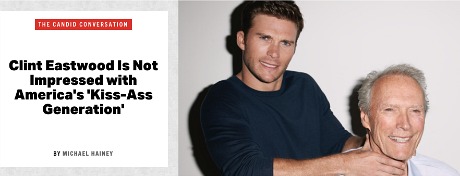Five hours ago HE pally Lewis Beale posted a Clint Eastwood defense on Facebook. Beale alludes to Eastwood’s remarks in Michael Hainey’s just-posted Esquire interview that has everyone calling him a rightwing dick who doesn’t respect p.c. guidelines, a clueless dinosaur and/or a real-deal incarnation of Walt Kowalski, the seething cranky guy he played in Gran Torino.

Understand before you read Beale’s essay that Eastwood doesn’t defend Donald Trump all around the block in the Esquire piece. Clint acknowledges that Trump has said some stupid things, although he seems to have a certain sympathy for Trump’s ongoing disdain of the p.c. dictatorship: .
“I know the p.c. crowd will be all over me for this,” Beale begins, “but the recent posts regarding Clint Eastwood’s defense of Donald Trump’s racist comments deserve some context. Human beings are complex creatures, which means that Eastwood is a set of contradictions. His defense of Trump is no doubt reprehensible, but in excoriating him a lot of people have forgotten that for years Eastwood has, in his own way, been one of the most racially sensitive people in Hollywood.
“Years ago a friend [reminded] me that Woody Allen, darling of film critics and urban intellectuals, never cast any minorities in his films, even as background. Yet Clint Eastwood, often reviled for his conservative/libertarian politics, has consistently cast, and acted with, black performers, many of them in key roles. I wrote a piece about this for the Los Angeles Daily News, and to this date no one has contradicted my findings.







